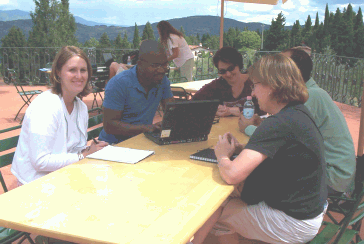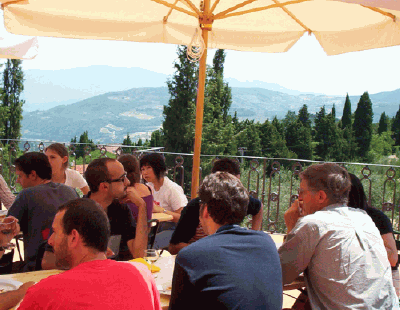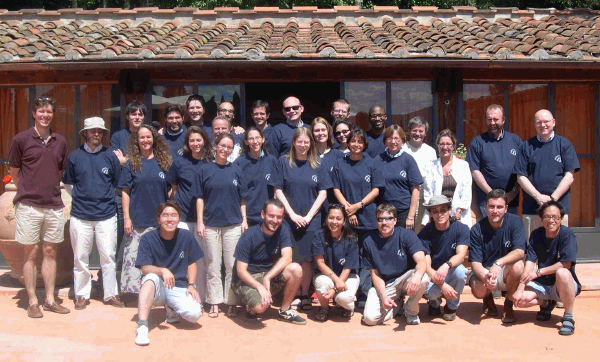
What do you get when you mix some of the brightest young (and not so young) Geographic Information researchers from US, Europe and around the world, expert senior instructors leading the discussion, wireless internet, and the backdrop of the Tuscan hills overlooking Florence, Italy? The Vespucci Summer School of course.
The summer school has become an integral part of the not-for-profit
Vespucci Initiative (see www.vespucci.org),
which was established in 2002 with the goal of channeling and continuing
the positive energy created by European Science
Foundation (ESF) and US National Science
Foundation (NSF)-funded events, including past summer schools held
jointly in order to foster cross-Atlantic cooperation.These previous events
convinced a lot of people that holding retreat-like sessions in "special"
locations should not be confused with junkets; the atmosphere created is
unmatched for creative thinking and for establish productive international
relationships. Vespucci continues this tradition, and encourages
deep, critical thinking on some of the pressing issues related to the use
of Geographic Information in current and future society.

Continuing on the success of the 2003 event, the 2004 summer school
was held from 5 to 16 July on an olive oil farm near Fiesole.
There students (and instructors) were treated to 2 weeks of intense thinking
and group work.
Week 1 focused on Spatial Analysis, and was lead by international specialists Michael Goodchild (U California Santa Barbara) and Robert Haining (U Cambridge).
Week 2, lead by Ian Masser, Max Craglia, Werner Kuhn and Michael Gould, focused on Spatial Data Infrastructures (SDI) from a unique, research methods perspective.Students worked on group proposal-writing exercises focused on the real scenario of building a multilingual, regional SDI in Europe.
Part of the summer school's success comes from the quality and diversity of the students selected, many of whom are NOT GIS specialists but, rather, researchers from the edge, looking in to see what GI can do for them and vice versa. A quote from one of these students is the following:
"The 2004 Vespucci Initiative Summer School program (Week 2) greatly exceeded my expectations, and opened my eyes to a number of entirely new disciplinary, as well as cultural, horizons. As a fisheries biologist/ecologist, interested in regional community structures, I employ geographic information (GI) on a daily basis, and the success of my research is largely beholden to the spatial data infrastructures (SDI's) that provide access to regional datasets.Because geographic information systems are but one critically important tool in my program, I am not in the habit of pondering the technical possibilities that more sophisticated SDI's might allow. You can therefore imagine what an illuminating, exciting time the Vespucci Initiative was for me; I had no idea that such intricate GI systems were even possible, let alone that exceedingly qualified people were already working to realize them. The potential value of SDI's to researchers in the natural sciences is tremendous, and I fully intend to tap this resource in the future."This is just one example of the diverse group which included MBAs, practitioners from regional government, and especially a group of US-based Ph.D.researchers who were sponsored by an IGERT grant (NSF funding) under the direction of Prof David Mark at University at Buffalo, who will join the summer schools in the coming years.

Results
Vespucci summer school sessions are not so much prescriptive (students quietly taking notes) as they are brainstorming sessions which actually produce new results.One of many results of week 1, was that the bridge between spatial analysis tools and GIS seems indeed to be getting stronger. Also notable was wide acceptance of free tools such as GeoDa alongside commercial ones such as ESRI Spatial Analyst.
The second week on SDIs was considerably more forward looking and critical, producing among others these results:
- SDI still a rather unknown entity outside the main GIS circle: greater and wider communication is necessary.
- Confusion over difference between "true" SDI (as in the European INSPIRE initiative or Geospatial One Stop) and the more isolated corporate GIS or mapping projects
- Metadata creation+management needs to move to 21st century technology, models (data providers doing manual data entry to create text files is not where we'd like to be now in 2004)
- Specialists from the fringe --biologists, sociologists-- have many interesting perspectives to offer the core GI(S) community
- SDI still understood mostly as technology-oriented rather than focusing on more critical factors such as institutional and political
- Semantics issues will play a key role in harmonizing SDIs and/or GI communities
- True user needs analysis seem quite rare....most SDIs start with technology demos or political initiatives
- Perhaps sociology (not technology, nor Geography) is at the "root" of determining how, why, when to build SDI....
- Capacity-building, including life-long learning, is necessary to help assure sustainability of SDI projects.

Next year's topics will be (tentatively) Risk Management and Geodemographics and Public Participation.
The Vespucci summer school is made possible thanks in part to sponsors such as, this year, Intergraph, ESRI, NSF, Ordnance Survey GB, ASITA, the Geoide Network and, of course, Directions Magazine. The Vespucci Initiative organizers warmly thank Directions Magazine for supporting the summer school and helping to push forward the frontier.